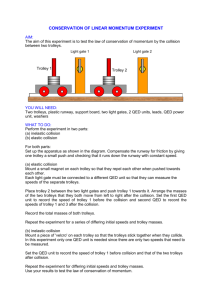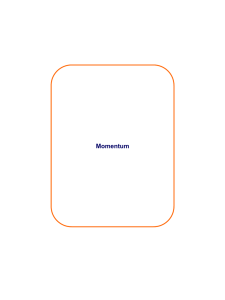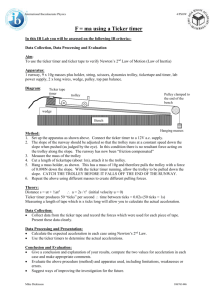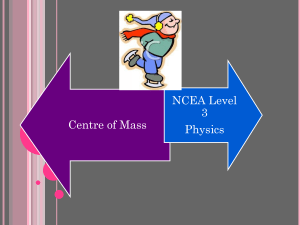Aim: To verify the Principle of Conservation of Momentum
advertisement
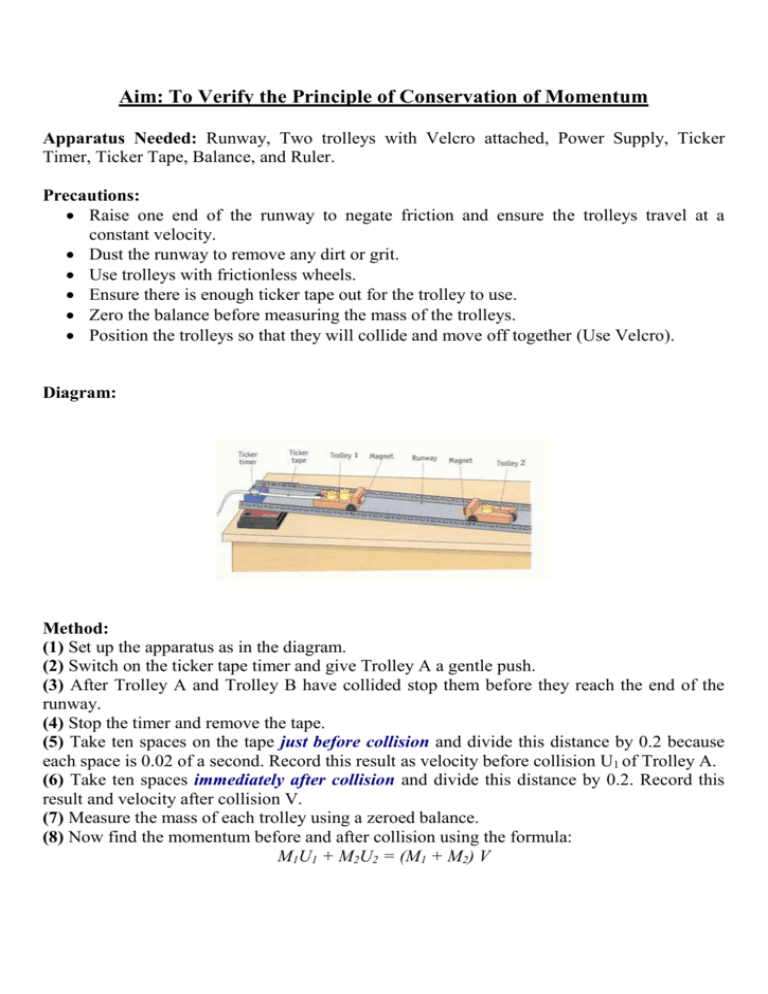
Aim: To Verify the Principle of Conservation of Momentum Apparatus Needed: Runway, Two trolleys with Velcro attached, Power Supply, Ticker Timer, Ticker Tape, Balance, and Ruler. Precautions: Raise one end of the runway to negate friction and ensure the trolleys travel at a constant velocity. Dust the runway to remove any dirt or grit. Use trolleys with frictionless wheels. Ensure there is enough ticker tape out for the trolley to use. Zero the balance before measuring the mass of the trolleys. Position the trolleys so that they will collide and move off together (Use Velcro). Diagram: Method: (1) Set up the apparatus as in the diagram. (2) Switch on the ticker tape timer and give Trolley A a gentle push. (3) After Trolley A and Trolley B have collided stop them before they reach the end of the runway. (4) Stop the timer and remove the tape. (5) Take ten spaces on the tape just before collision and divide this distance by 0.2 because each space is 0.02 of a second. Record this result as velocity before collision U1 of Trolley A. (6) Take ten spaces immediately after collision and divide this distance by 0.2. Record this result and velocity after collision V. (7) Measure the mass of each trolley using a zeroed balance. (8) Now find the momentum before and after collision using the formula: M1U1 + M2U2 = (M1 + M2) V Sample Results: Mass of A/kg Mass of B/kg U1 / ms-1 V / ms-1 0.2 0.22 1 0.5 0.2 0.32 1.43 0.56 0.3 0.42 1.25 0.53 Data Pair One M1U1 + M2U2 = (M1 + M2) V (0.2) (1) + (0.22) (0) = (0.2 + 0.22) (0.5) 0.2 kgms-1 = 0.2 kgms-1 Data Pair Two M1U1 + M2U2 = (M1 + M2) V (0.2) (1.43) + (0.32) (0) = (0.2 + 0.32) (0.56) 0.29 kgms-1 = 0.29 kgms-1 Data Pair Three M1U1 + M2U2 = (M1 + M2) V (0.3) (1.25) + (0.42) (0) = (0.3 + 0.42) (0.53) 0.38 kgms-1 = 0.38 kgms-1 Conclusion: Within the limits of experimental error, the principle of conservation of momentum has been verified. It states that in any collision the momentum of two or more bodies before interaction is equal to the momentum afterwards provided no external forces act on the system of bodies. Possible Questions: (1) Describe the apparatus which might have been used in the experiment. Draw a diagram of the apparatus as shown above. Trolley A is attached to the ticker tape which is threaded through the ticker tape timer. Both trolleys have Velcro on one end so that when they collide they attach and move off together. It is a low-friction runway and the trolleys have frictionless wheels. The books underneath the runway raise it to negate friction. Also by having Trolley A moving at constant velocity, we negate gravity. (2) Describe how the time interval was measured. If the distance measured was 0.2 m for example count the number of spaces in the measured distance. Multiply the number of spaces by 0.02 because the ticker timer produces one dot ever 0.02 seconds. The result of these calculations is the time. (3) Using the data: (i) calculate the velocity of body A before and after collision, and (ii) show how the experiment verifies the principle of conservation of momentum. On previous page (4) How were the effects of friction and gravity minimised in the experiment? Friction was minimised by raising the runway on top of books to give a slope. Also by dusting runway and oiling the wheels. Gravity was minimised by having the trolley move with a constant velocity. (5) Give one precaution which might have been used to improve the accuracy of this experiment. Dust the runway to remove and dirt and grit which might slow the trolleys. Principle of Conservation of Momentum Mistakes Students don't state what the principle of momentum is. You must include this always in your experiment. You must must must state the formulae that you will be using, ie The following formulae are used: M1U1 + M2U2 = (M1 + M2) V ***************This one is most common************* Or M1U1 + M2U2 = M1V1+ M2V2 velocity = distance / time You must explain to the examiner how you got u, v, and t. E.G. To Find U: Measure the distance for 10 spaces just before collision in millimetres. Convert to meters. Divide by 0.2 s as there is a time of 0.02 s between each space. Find the momentum just before and just after the collision. State that u is 10 spaces just before the collision and v is 10 spaces just after the collision. (As dots will be clustered together at collision) Precautions Dust runway to negate friction. Raise the runway to negate friction. Oil wheels to negate friction. Ensure that we get constant velocity when we give it a gentle push to overcome gravity Repeat experiment at least 6 times.
